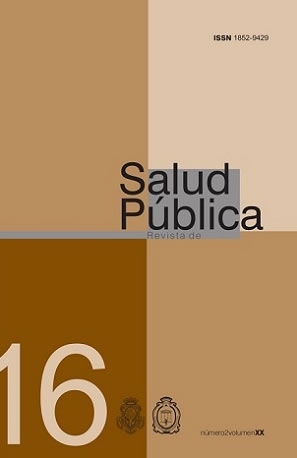ENVIRONMENTAL SETTING OF THE INDEX CASE OF SKIN LEISHMANIASIS, UNQUILLO, CORDOBA
DOI:
https://doi.org/10.31052/1853.1180.v20.n2.14353Keywords:
leishmaniasis, Lutzomya, Unquillo, CordobaAbstract
ABSTRACT
INTRODUCTION AND OBJECTIVES: Cordoba hills are located to the WEST of the province and are arranged in three mountain ranges, in one of these, on the EASTERN slope, we find the town of Unquillo, place of the first autonomous case of skin leishmaniasis in the province of Cordoba, Argentina, which was reported and published by us (1).We consider important to gather information about environmental and demographic factors that may have favored the settlement of Lutzomya spp. MATERIALS AND METHODS: On-site inspection, observational examination of the city and surrounding areas, bibliographic analysis of statistics, census, geomorphology and phytogeography were used to characterize the pattern which functions as the ecological niche for the vector.RESULTS: The geography of Unquillo presents slopes, faults and ravines, with soil rich in organic nutrients, good levels of rainfalls and human activity patches in the wild environment resulting in the ideal setting for the settlement and reproduction of the transmitting insect. CONCLUSIONS: The study shows the so-called draining corridors of Lutzomya spp., convergent from endemic provinces with the zoonosis towards these mountain tows; Unquillo among them. The analysis adds extra value and a threat for public health if we consider the proximity of this town to the large city of Cordoba
Downloads
References
1. Pizzi HL, Tomas AF, Ferrero MR, Pizzi HL(h), Fernández GL, Furey F, Pizzi RD, Herrero M, Dib MD. El inexorable avance de la leishmaniasis: comunicación del primer caso autóctono en la provincia de Córdoba. Revista de Salud Pública, 2015. (XIX). Pág. 15-23.
2. Pizzi HL, Sánchez RJ, Huck GA; Artrópodos. Su impacto en la salud. Córdoba, Argentina. Edit. Rotagraf. 2007. Pág.117-18.
3. Pizzi HL, Sánchez RJ, Huck GA, Tomas AF; Artrópodos. Calentamiento global. Nuevos desafíos. Control de plagas. Córdoba, Argentina. Edit. Rotagraf. 2012. Pág. 139-141.
4. Nirich Ronga S. Regiones Naturales de la Provincia de Córdoba. AGENCIA CÓRDOBA D.A.C.yT, Dirección de Ambiente, 2003. Disponible en: En:http://www.igualdadycalidadcba.gov.ar/SIPEC CBA/publicaciones/proyarboles/RegionesNaturalesdeCordoba.pdf
5. Pizzi HL, Sánchez RJ, Huck GA. Protozoología. Córdoba, Argentina. Edit. Rotagraf, 2012. Pág. 45-55.
6. Dirección General de Estadística y Censos de la Provincia de Córdoba. Censo Nacional 2010. Disponible en: http://estadistica.cba.gov.ar/.
7. Instituto Nacional de Parasitología Dr. Mario Fatala Chaben. [Internet] CABA. 2015. [Citado 5 de Mayo 2015]. Leishmaniasis. Disponible en: http://www.anlis.gov.ar/ inp/?page_id=316 , 7. OMS. Leishmaniasis. [Internet] [Citado 5 de Mayo 2015]. Nota descriptiva N°375. Disponible en: http://www.who.int/mediacentre/factsheets/fs375/es/).
8. Capitanelli J. a. Geomorfología. En: Vázquez JB, Miatello RA & ME Roqué (Directores). Geografía Física de la Provincia de Córdoba. Banco de la Provincia de Córdoba. Editorial Boldt, Buenos Aires, Argentina.1979. Pág.144-203
9. Capitanelli J. b. Clima. En: Vázquez JB, Miatello RA & ME Roqué (Directores). Geografía Física de la Provincia de Córdoba. Banco de la Provincia de Córdoba. Editorial Boldt, Buenos Aires, Argentina.1979. Pág. 213-296
10. Gavier GI, Bucher EH: Deforestación de las Sierras Chicas de Córdoba (Argentina) en el período 1970-1997. Academia Nacional de Ciencias,Córdoba, Rep. Argentina. 2004. Miscelánea Nº 101.
11. SIAN (Sistema Información Ambiental Nacional) http://www.ambiente.gov.ar.
12. Salomon OD, Quintana MG, Mastrangelo AV, Fernández MS. Leishmaniasis and Climate Change. Case Study: Argentina Journal Tropical Medicine:2012 Pág.1-12.
13. Salomón OD, Orellano PW, Quintana MG, Pérez S, Sosa Estani S, Acardi SA, Lamfri M. 2006. Transmisión de leishmaniasis tegumentaria en la Argentina. Medicina (Buenos Aires) 66. Pág. 211-219.
14. Salomón OD. Phlebotominae - Flebótomos. Editor. Artrópodos de interés médico en Argentina. Buenos Aires: Fundación Mundo Sano; Publicación Monográfi ca. 2005. 6. Pág.67-73.
15. Walsh JF, Molyneux DH, Birley MH. Deforestation: effects on vector-borne disease. Parasitology.1993. 106. Pág.55–75.
16. Ashford R.Leishmaniasis reservoirs and their signifi cance in control. Clinical Dermatology. 1996.14. Pág.523–532.
17. Lainson R. Demographic changes and their infl uence on the epidemiology of the American leishmaniases, in M. W. Service Eds. Demography and vector-borne diseases. CRC Press, Boca Raton, Fla. 1989. Pág.85-106.
18. Woolhouse ME, Dye C, Etard JF, Smith T, Charlwood JD, Garnett GP, et al. Heterogeneities in the transmission of infectious agents: implications for the design of control programs. Proceedings of the National Academy of Sciences (USA). 1997. Pág. 338-342.
19. Santini MS, Fernández MS, Pérez AA, Sandoval AE, Salomón OD.Lutzomyia longipalpis abundance in the city of Posadas, northeastern Argentina: variations at different spatial scales. Memorias do Instituto Oswaldo Cruz, Rio de Janeiro.2012. Pág.106-7.
20. Santini MS, Salomón OD, Acardi SA, Sandoval EA, Tartaglino LC.Lutzomyia longipalpis behavior at an urban visceral leishmaniasis focus in Argentina. Rev. do Instituto de Medicina Tropical de São Paulo.2010.52. Pág. 187-191.
21. Salomón OD. Mesa redonda: Infecciones emergentes y re-emergentes en un mundo globalizado.XVI Jornadas Argentinas de Microbiología y III Congreso Bioquímico del Litoral.Santa Fe, Argentina, 5, 6 y 7 de Agosto de 2015.
22. Tamburini D, Kufner M. Procesos ecológicos y sociales de ocupación del espacio en la Sierra Chica de Córdoba, Argentina. Gestión Ambiental (Chile) 2006.12. Pág. 41-54.
23. Moiso A. Determinantes de la Salud. En: Fundamentos de epidemiología. Cap 6. La Plata. 2007. Pág. 161-188. Disponible en: http://www.inus.org.ar/documentacion/DocumentosTecnicos.
Downloads
Published
Issue
Section
License
Copyright (c) 2016 Escuela de Salud Pública y Ambiente. Facultad de Ciencias Médicas. Universidad Nacional de Córdoba

This work is licensed under a Creative Commons Attribution-NonCommercial 4.0 International License.
Authors who publish with this journal agree to the following terms:
- Authors retain copyright and grant the journal right of first publication with the work simultaneously licensed under a Creative Commons Attribution License which allows the work to be copied, distributed, exhibited and interpreted as long as it is not done for commercial purposes.
- Authors are able to enter into separate, additional contractual arrangements for the non-exclusive distribution of the journal's published version of the work (e.g., post it to an institutional repository or publish it in a book), with an acknowledgement of its initial publication in this journal.
- Authors are permitted and encouraged to post their work online (e.g., in institutional repositories or on their website) after the publication process. (See The Effect of Open Access). (See The Effect of Open Access).







